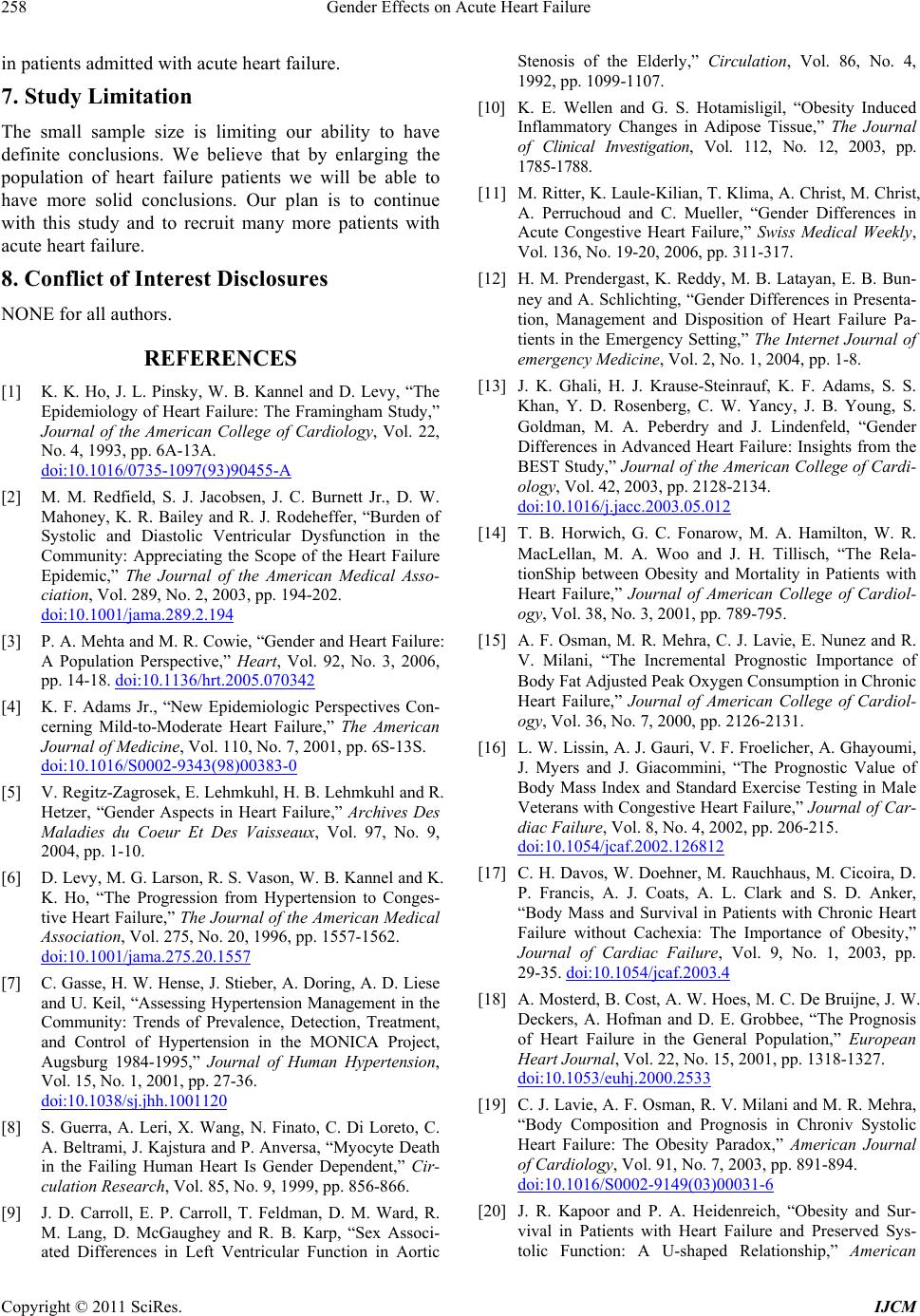
Gender Effects on Acute Heart Failure
258
in patients admitted with acute heart failure.
7. Study Limitation
The small sample size is limiting our ability to have
definite conclusions. We believe that by enlarging the
population of heart failure patients we will be able to
have more solid conclusions. Our plan is to continue
with this study and to recruit many more patients with
acute heart failure.
8. Conflict of Interest Disclosures
NONE for all authors.
REFERENCES
[1] K. K. Ho, J. L. Pinsky, W. B. Kannel and D. Levy, “The
Epidemiology of Heart Failure: The Framingham Study,”
Journal of the American College of Cardiology, Vol. 22,
No. 4, 1993, pp. 6A-13A.
doi:10.1016/0735-1097(93)90455-A
[2] M. M. Redfield, S. J. Jacobsen, J. C. Burnett Jr., D. W.
Mahoney, K. R. Bailey and R. J. Rodeheffer, “Burden of
Systolic and Diastolic Ventricular Dysfunction in the
Community: Appreciating the Scope of the Heart Failure
Epidemic,” The Journal of the American Medical Asso-
ciation, Vol. 289, No. 2, 2003, pp. 194-202.
doi:10.1001/jama.289.2.194
[3] P. A. Mehta and M. R. Cowie, “Gender and Heart Failure:
A Population Perspective,” Heart, Vol. 92, No. 3, 2006,
pp. 14-18. doi:10.1136/hrt.2005.070342
[4] K. F. Adams Jr., “New Epidemiologic Perspectives Con-
cerning Mild-to-Moderate Heart Failure,” The American
Journal of Medicine, Vol. 110, No. 7, 2001, pp. 6S-13S.
doi:10.1016/S0002-9343(98)00383-0
[5] V. Regitz-Zagrosek, E. Lehmkuhl, H. B. Lehmkuhl and R.
Hetzer, “Gender Aspects in Heart Failure,” Archives Des
Maladies du Coeur Et Des Vaisseaux, Vol. 97, No. 9,
2004, pp. 1-10.
[6] D. Levy, M. G. Larson, R. S. Vason, W. B. Kannel and K.
K. Ho, “The Progression from Hypertension to Conges-
tive Heart Failure,” The Journal of the American Medical
Association, Vol. 275, No. 20, 1996, pp. 1557-1562.
doi:10.1001/jama.275.20.1557
[7] C. Gasse, H. W. Hense, J. Stieber, A. Doring, A. D. Liese
and U. Keil, “Assessing Hy pertension Management in the
Community: Trends of Prevalence, Detection, Treatment,
and Control of Hypertension in the MONICA Project,
Augsburg 1984-1995,” Journal of Human Hypertension,
Vol. 15, No. 1, 2001, pp. 27-36.
doi:10.1038/sj.jhh.1001120
[8] S. Guerra, A. Leri, X. Wang, N. Finato, C. Di Loreto, C.
A. Beltrami, J. Kajstura and P. Anversa, “Myocyte Death
in the Failing Human Heart Is Gender Dependent,” Cir-
culation Research, Vol. 85, No. 9, 1999, pp. 856-866.
[9] J. D. Carroll, E. P. Carroll, T. Feldman, D. M. Ward, R.
M. Lang, D. McGaughey and R. B. Karp, “Sex Associ-
ated Differences in Left Ventricular Function in Aortic
Stenosis of the Elderly,” Circulation, Vol. 86, No. 4,
1992, pp. 1099-1107.
[10] K. E. Wellen and G. S. Hotamisligil, “Obesity Induced
Inflammatory Changes in Adipose Tissue,” The Journal
of Clinical Investigation, Vol. 112, No. 12, 2003, pp.
1785-1788.
[11] M. Ritter, K. Laule-Kilian, T. Klima, A. Christ, M. Christ,
A. Perruchoud and C. Mueller, “Gender Differences in
Acute Congestive Heart Failure,” Swiss Medical Weekly,
Vol. 136, No. 19-20, 2006, pp. 311-317.
[12] H. M. Prendergast, K. Reddy, M. B. Latayan, E. B. Bun-
ney and A. Schlichting, “Gender Differences in Presenta-
tion, Management and Disposition of Heart Failure Pa-
tients in the Emergency Setting,” The Internet Journal of
emergency Medicine, Vol. 2, No. 1, 2004, pp. 1-8.
[13] J. K. Ghali, H. J. Krause-Steinrauf, K. F. Adams, S. S.
Khan, Y. D. Rosenberg, C. W. Yancy, J. B. Young, S.
Goldman, M. A. Peberdry and J. Lindenfeld, “Gender
Differences in Advanced Heart Failure: Insights from the
BEST Study,” Journal of the American College of Cardi-
ology, Vol. 42, 2003, pp. 2128-2134.
doi:10.1016/j.jacc.2003.05.012
[14] T. B. Horwich, G. C. Fonarow, M. A. Hamilton, W. R.
MacLellan, M. A. Woo and J. H. Tillisch, “The Rela-
tionShip between Obesity and Mortality in Patients with
Heart Failure,” Journal of American College of Cardiol-
ogy, Vol. 38, No. 3, 2001, pp. 789-795.
[15] A. F. Osman, M. R. Mehra, C. J. Lavie, E. Nunez and R.
V. Milani, “The Incremental Prognostic Importance of
Body Fat Adjusted Peak Oxygen Consumption in Chronic
Heart Failure,” Journal of American College of Cardiol-
ogy, Vol. 36, No. 7, 2000, pp. 2126-2131.
[16] L. W. Lissin, A. J. Gauri, V. F. Froelicher, A. Ghayoumi,
J. Myers and J. Giacommini, “The Prognostic Value of
Body Mass Index and Standard Exercise Testing in Male
Veterans with Congestive Heart Failure,” Journal of Car-
diac Failure, Vol. 8, No. 4, 2002, pp. 206-215.
doi:10.1054/jcaf.2002.126812
[17] C. H. Davos, W. Doehner, M. Rauchhaus, M. Cicoira, D.
P. Francis, A. J. Coats, A. L. Clark and S. D. Anker,
“Body Mass and Survival in Patients with Chronic Heart
Failure without Cachexia: The Importance of Obesity,”
Journal of Cardiac Failure, Vol. 9, No. 1, 2003, pp.
29-35. doi:10.1054/jcaf.2003.4
[18] A. Mosterd, B. Cost, A. W. Hoes, M. C. De Bruijne, J. W.
Deckers, A. Hofman and D. E. Grobbee, “The Prognosis
of Heart Failure in the General Population,” European
Heart Journal, Vol. 22, No. 15, 2001, pp. 1318-1327.
doi:10.1053/euhj.2000.2533
[19] C. J. Lavie, A. F. Osman, R. V. Milani and M. R. Mehra,
“Body Composition and Prognosis in Chroniv Systolic
Heart Failure: The Obesity Paradox,” American Journal
of Cardiology, Vol. 91, No. 7, 2003, pp. 891-894.
doi:10.1016/S0002-9149(03)00031-6
[20] J. R. Kapoor and P. A. Heidenreich, “Obesity and Sur-
vival in Patients with Heart Failure and Preserved Sys-
tolic Function: A U-shaped Relationship,” American
Copyright © 2011 SciRes. IJCM